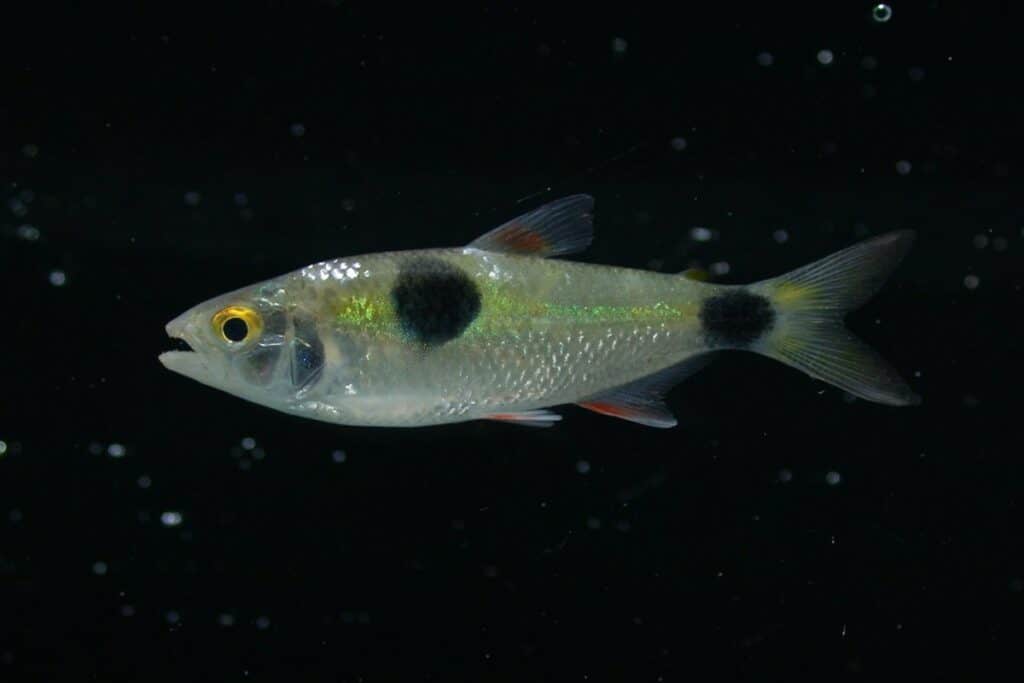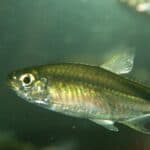If you’ve ever heard of a Bucktooth Tetra, you know very well that this is an aggressive fish. Aggressiveness is something that many fish keepers view as a negative trait. We held the same belief when we were starting out too.
But a lot of aggressive fish, especially the Bucktooth Tetra, are actually quite interesting, displaying a wide range of captivating appearances and behaviors. And get this: the more you learn about these fish, the more you understand that aggressiveness is fairly manageable.
So if you’re not intimidated by a little bit of spunk, read this Bucktooth Tetra profile.

Species Summary
The Bucktooth Tetra (Exodon paradoxus) is a fish from the characid family that inhabits South America, more precisely, the Amazon and Tocantins basins. It is usually found near riverbanks amid dense vegetation.
This fish is much more vicious than the piranha, which is a well-known predator. That’s why this fish is not recommended to be held in community aquariums, as it can peel off the scales of other species and eat them.
On the bright side, the Bucktooth Tetra is not very demanding in relation to water parameters and does well in the same water conditions as many South American tropical fish species.
Bucktooth Tetra Care Guide
As has been noted, the Bucktooth Tetra is aggressive and territorial. Know what you’re getting yourself into by learning its tank size requirements, tank mates, and more.
Tank Size
As well as being aggressive, this fish is highly active, so the tank needs to have a minimum of 44 gallons for a group of 10 fish.
Tank Mates
Community aquarium breeding should be avoided, although it can be successfully done with some plecos and larger Characids, such as Leporinus.
Add the Bucktooth Tetra last if you choose to keep it in a community aquarium. Good tank mates include scaleless fish like Lungfish and any type of Catfish.
Same Species Tanks
The Bucktooth Tetra thrives in large groups when placed in an aquarium specifically for this species. Therefore, it is not uncommon to see them kept in such aquariums.
Water Parameters
You can treat it like other tetras in the same region; they inhabit warm, soft, and acidic waters.
This species of fish lives best in water between 73 and 82 degrees Fahrenheit. In order for the fish to be properly maintained, the temperature should never exceed 31°C for long periods. The nitrate content should remain below 50mg/L.
It is also ideal to keep the pH from 5.5 to 7.5 and the hardness from 1 to 20. This parameter difference is relative to the location where the fish was collected.
What to Put in Their Tank
These species do best when kept in a densely planted aquarium, although they don’t care much for the formation of hiding places. The refuge provided by this type of aquarium will enable weaker individuals to hide from and avoid attacks by their congeners.
It is ideal for those who wish to keep a large shoal of a predatory species but do not require as much space as would be necessary for a shoal of piranha or similar.
Use sandy substrate and roots to characterize its biotope. You can also add some hardy plants like Java Ferns and Amazon Swords. But don’t overcrowd the aquarium with plants; Bucktooth Tetras should be kept in peripheral regions with a wide open area for swimming. This is because these fish are active and need space to swim.
Common Diseases
The fish in this aquarium relies on the water being in perfect condition at all times to stay active and healthy. If Bucktooth Tetras are kept in tanks with unstable water, they may have problems such as Ich and Fin Rot.
Food and Diet
This brave species is carnivorous; in nature, it feeds on small invertebrates and insects, although its favorite food is the scales of other fish.
Aquarists often provide live or dead fish to feed this species, but there is no immediate need to provide live food; you can give frozen or fresh food.
Make sure to provide brine shrimp, bloodworms, earthworms, and insects. More importantly, ensure all individuals are getting enough food so that cannibalism does not occur among them.
Lifespan
Bucktooth Tetras have a considerable life expectancy and can easily exceed 5 years of life in perfect conditions.
Appearance
The Bucktooth Tetra’s body is elongated and compressed, with a mouth that points forward. It has scalloped lips and powerful jaws for its size.
Its teeth are more pronounced and well-developed than many tetras; its base body color is silver, and its scales exhibit a greenish-yellow hue.
The dorsal, pectoral, and ventral fins are light yellow, while the caudal fin is reddish. It also has a line that runs through its entire body. On this line, there are two large black spots with yellow borders; one below the dorsal fin and the other on the caudal peduncle.
Size
They are sizable tetras, quickly reaching 2.9 inches in length.
Behavior and Temperament
Bucktooth Tetras are active, swimming around the aquarium to explore and exercise. Also, they habitually nibble other fish and remove their scales or fins.
They tend to pick weaker targets and frequently attack if kept in smaller groups. If you have a huge aquarium, don’t be afraid to form a group of 25 to 50 individuals.
Larger shoals typically result in fewer individuals being shot, with the exception of sick or unhealthy specimens that need to be killed; even so, losses may still occasionally occur.
Breeding
Like other tetras, it is oviparous. The male will lead the female to release the eggs amid plants or substrate, which will then be fertilized. Parents do not exhibit parental care.
Breeding the Bucktooth Tetra in captivity is possible but extremely rare. If you want to breed them, it’s best to try them in a separate aquarium.
Set up a small breeding tank with similar parameters to the main tank; the water should have a pH of 6.0-6.5. Add thin-leaved plants, as the species usually disperses its eggs among the leaves.
Try to condition the fish on a high-protein diet for several days before trying to breed them. Then select a pair of the species and move them to the breeding tank.
To start spawning, you can perform a partial water change of about 50 percent. However, use slightly warmer water to simulate the temperature changes of the breeding season. If you are lucky, the female will scatter the eggs around the aquarium. When this happens, remove the parents to give the eggs a chance to survive.
Eventually, the eggs will hatch in two or three days, and when the fry swims freely around the aquarium, you can feed them brine shrimp nauplii.
Gender Differences: Male vs Female
With regard to sexual dimorphism, adult males sport a rectilinear body shape (thinner and longer), brighter colors, and more extended fins. They also tend to have finely elongated dorsal and anal rays. At the same time, females are more robust, especially when adults.
Bucktooth Tetra Fun Facts
- It occurs throughout the Brazilian Amazon and part of the Rio Branco in Guyana.
- It has a fusiform body and a terminal mouth with a long and evident maxillary bone. Its coloration is yellowish gray with the upper part of the dark head gray; it still has two black spots, one on the flank and the other on the caudal peduncle; yellowish fins.
- The genus Exodon is currently monotypic, with this single species having protruding teeth. These allow the tearing of the scales of other fish species to feed.
- The interaction of a large group is fascinating to watch, as they constantly vie with each other and how the group’s leaders feature flashy colors.
References
Géry, J., 1977. Characoids of the world. Neptune City; Reigate: T.F.H. [etc.]; 672 p.: ill. (chiefly col.).
Lima, F.C.T., L.R. Malabarba, P.A. Buckup, J.F. Pezzi da Silva, R.P. Vari, A. Harold, R. Benine, O.T. Oyakawa, C.S. Pavanelli, N.A. Menezes, C.A.S. Lucena, M.C.S.L. Malabarba, Z.M.S. Lucena, R.E. Reis, F. Langeani, C. Moreira et al. …, 2003. Genera Incertae Sedis in Characidae. P. 106-168. In R.E. Reis, S.O. Kullander and C.J. Ferraris, Jr. (eds.) Checklist of the Freshwater Fishes of South and Central America. Porto Alegre: EDIPUCRS, Brazil.
Lucena, C.A.S., 1998. Phylogenetic relationships and definition of the genus Roeboides, Günther (Ostariophysi; Characiformes; Characidae). common Mus. Science Tech PUCRS, Sr. zoo Porto Alegre (CMCT), 11:19-59.








